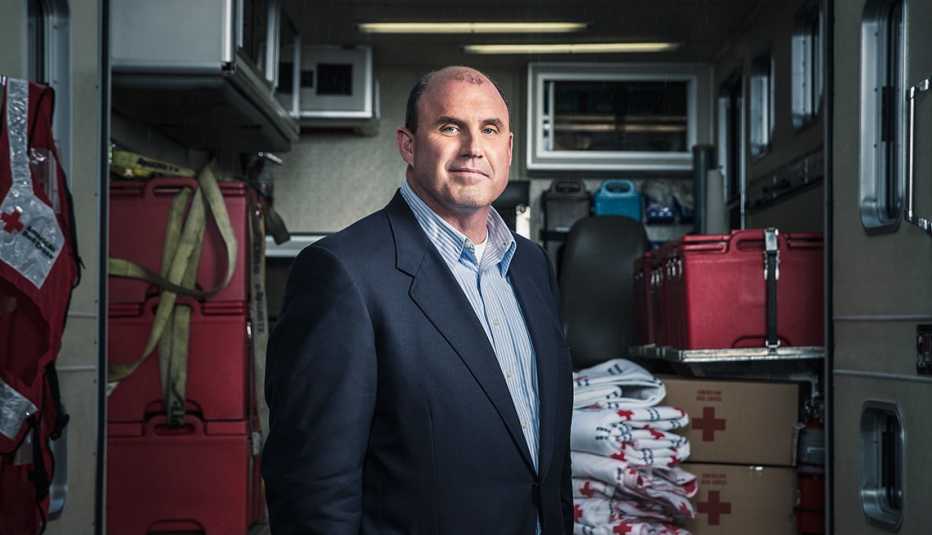AARP Hearing Center


Sixty seconds after takeoff, Dave Sanderson heard the explosion.
"I had never heard anything like that on a plane before," he recalls. "I was sitting four rows behind the left wing. I looked out and saw fire."
Sanderson, 53, flew often for his work as a software sales manager for Oracle, and he didn't panic. "My first thought was that we had lost an engine," he says. "I thought we'd just circle back to LaGuardia and land."
Here's what Sanderson didn't know: US Airways Flight 1549 had collided with a flock of geese, disabling both engines. What happened next that January day in 2009 was soon dubbed the "Miracle on the Hudson" — the flight's captain, Chesley B. "Sully" Sullenberger III, managed to guide his crippled airliner to the frigid Hudson River and execute an extraordinary emergency landing.
When the jet hit the river, the impact broke Sanderson's seat and water poured into the cabin. But his first instinct was to stay aboard to help make sure others got out: "I remembered my mom saying to me when I was a kid, 'If you do the right thing, God will take care of you.' "
By the time Sanderson made it to an exit, the plane's wings were partially submerged. He jumped into the icy water and began swimming to a rescue boat. "Two people on a ferryboat reached down and pulled me up. I was so cold, I couldn't feel a thing," he says. "When we reached the shore, three people greeted me — two emergency medical technicians and a guy with an American Red Cross blanket."
Sanderson was unhurt, but he was not unchanged. He began speaking about his experience at Red Cross fundraisers. Last year, he resigned from Oracle to devote himself to fundraising and speaking. He's helped raise more than $7 million for the Red Cross; a book is in the works, too. "The crash changed my perspective," he says. "I started scheduling around my family instead of my job."
Sanderson experienced a particularly dramatic life event — the kind of high-voltage bolt out of the blue that strikes many of us eventually. Midlife is prime time for such jolts: It's the season for sudden job loss, divorce, the deaths of loved ones, and all manner of health scares, disasters and near misses. Hollywood may love a good story about the stereotypical life-changing "midlife crisis" that's brought on by the anxiety of getting older, but research shows that most such crises instead are triggered by external events.
Midlife jolts can derail us — or they can propel us into reclaiming and remaking our lives. "They make people go higher and deeper, asking themselves questions about what is going on and how to get their arms around it," says Richard Leider, career counselor and coauthor of the new AARP book Life Reimagined: Discovering Your New Life Possibilities.
Leider says jolts can sometimes prompt risk taking: "People want to be more authentic the second time around. They want a voice in things and to live their own life, not the one that was prescribed for them by parents or society. They want their lives to matter."
In 1995, Lawrence Calhoun, professor of psychology at the University of North Carolina at Charlotte, helped coin the term "post-traumatic growth" (PTG) for this phenomenon. "It's not just about being resilient," he says. "Resilience is when you get punched, stagger and then jump right back up. Post-traumatic growth is different — when you stand back up, you are transformed."
Like its more well-known sibling condition, post-traumatic stress disorder, PTG doesn't develop in everyone who experiences a life-changing shock, Calhoun says. "One consistent finding for people who do experience post-traumatic growth is a set of circumstances that 'rock your world.' It causes you to confront questions you hadn't confronted before, or see that understandings you had of the world no longer apply. People think, 'This must have happened for some reason — it doesn't make any damn sense to me, but I need to try to wrestle with it to find some meaning.' "
That struggle can inspire profound and lasting personal growth: After their jolts, some people become more compassionate toward the plight of others, move into new careers, and remake their worldviews and personalities. Their relationships with others grow deeper, and they may seek a stronger spiritual dimension in their lives. The question is, why do some of us crumple in the face of trauma, while others emerge stronger than ever?


From revelation to remarkable change
Not all jolts arrive with the drama of a crashing airliner. For Eva Leivas-Andino, the jolt came one night in 1997 while at the theater with her son, Paolo. As the curtain came down on Gross Indecency: The Three Trials of Oscar Wilde, a play about the writer's imprisonment for homosexuality, Paolo began sobbing uncontrollably. "Paolo got up and disappeared, so I went out to the lobby," says Leivas-Andino, now 70. "When he came back about 10 minutes later, I could tell he'd been crying. He said to me, 'One hundred years and nothing has changed.' "
Leivas-Andino already knew that Paolo, then 28, was gay. He'd revealed that eight years earlier, but it didn't have the effect he'd hoped for. "I wanted it to be out in the open and a point of discussion," he says today. "Instead, it became the elephant in the room."



































































More on health
Do You Know the Keys to Happiness?
Find out what you can do to boost your well-being